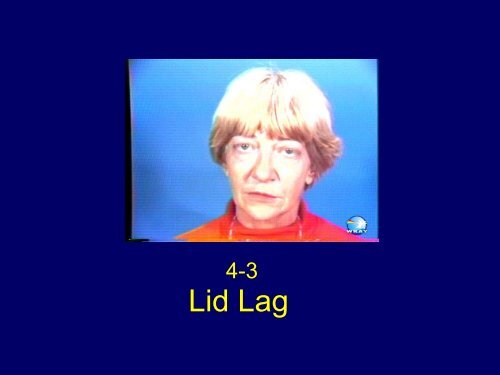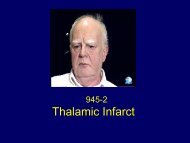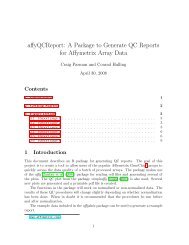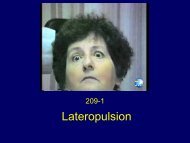Lid Lag
Lid Lag
Lid Lag
Create successful ePaper yourself
Turn your PDF publications into a flip-book with our unique Google optimized e-Paper software.
Classical Signs: TAOA prominent stare.Retraction of all four eyelidsBilateral exophthalmosHertel exophthalmometer 25 OD, 28 OS,base 108.Tight orbits/reduced orbital resilienceProminent congested scleral blood vesselsA visible rim of sclera on gentle eyeclosure
Eye Movements<strong>Lid</strong> lag (persistent elevation of the uppereyelid in downgaze) – von Graefe signMarked limitation of upward gazeMild limitation of downgazeRestricted horizontal eye movementsPositive forced duction test
Limited UpgazeLimitation of upgaze is due to tethering ofthe eyeball in the floor of the orbit by softtissue changes.Tethering of the eyeball inferiorly can beconfirmed by a forced duction test.
Limited Upgaze Duction Test1. Anesthetize the eye with topicalanesthesia2. Push on the globe with a cotton tip3. Pull with blunt tweezers to try to moveeye up.Mechanical restriction - a positive forcedduction test.
Compressive Optic NeuropathyMost serious complicationCrowding of the orbital apex by enlargedocular musclesPresent in 50% severe cases TAOMay require urgent orbital decompression
Figure 1 Axial CT through the orbit without contrastshows enlargement of the medial rectus musclebilaterally. Note that the tendinous insertion is spared.
Figure 2 The coronal CT (reformatted from axial data set)without contrast shows enlargement of the medial rectusmuscle, inferior rectus muscle and upper muscle complexon both sides.Courtesy of Hugh Curtin, M.D.
http://www.library.med.utah.edu/NOVEL
















